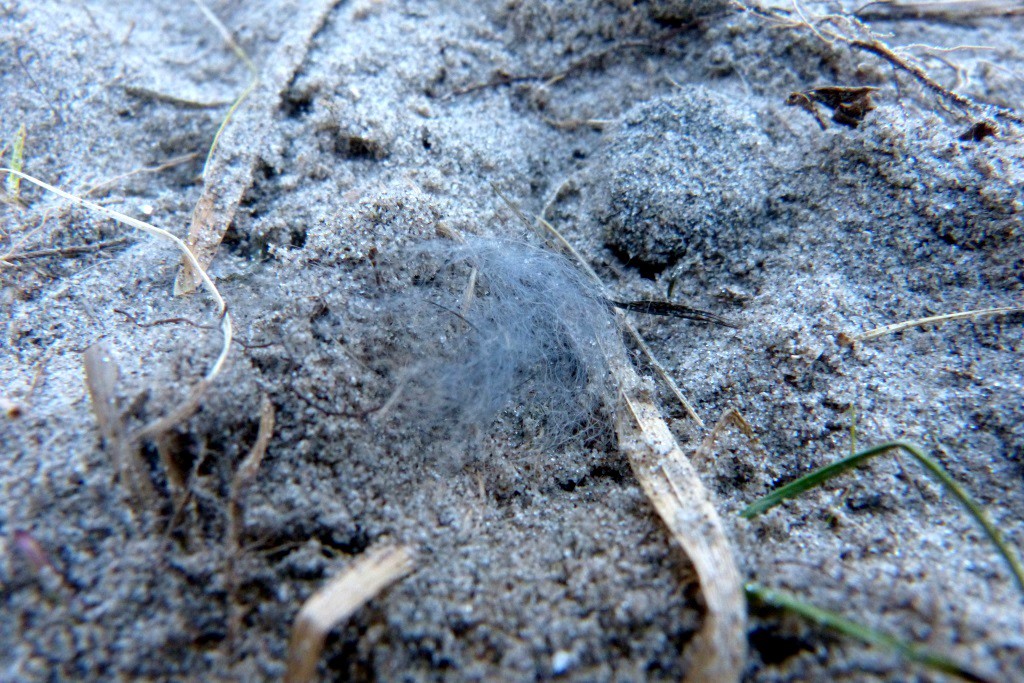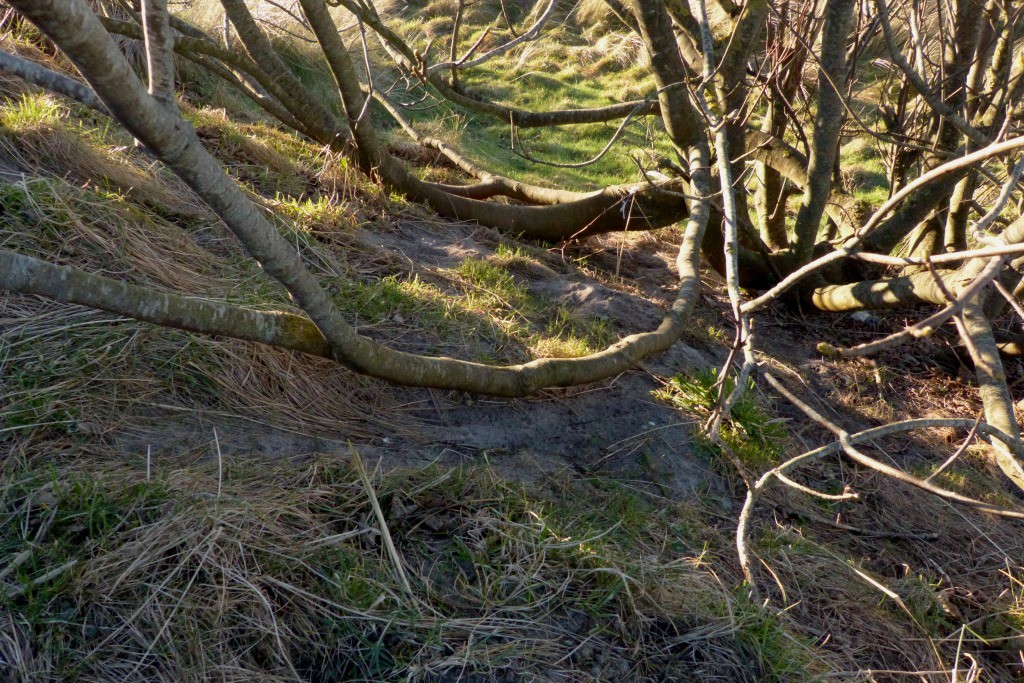By Sean Fagan

Red deer track on the shores of Lough Leine, Southwest Ireland (Photo: Sean Fagan).
When you find a track…look for a sign
Sometimes when I bring folks tracking I’m confronted with the all too human tendency to jump to conclusions (about tracks!).
It doesn’t help that tracking is wide open to interpretation (without necessarily a need to validate such interpretations - however tentative and speculative).
But hey, I’m human too and occasionally jump to conclusions when tracking. It’s something I try to curb within myself when tracking - as there is a fine line between making good guesses and erroneous speculation.
.
One way I’ve found to curb this all too human condition is to seek more tracks and sign within the immediate vicinity of a track or sign.
By doing this I greatly reduce my tendency for incorrect identification - because each animal leaves behind tracks and sign that is specific to its species – a tracking signature, if you will.
Also, making that extra effort to find tracks and sign associated with a lone track or sign can improve your ability to find more subtle tracking cues.
This is an important distinction - and a practice that will improve your tracking skills (often greatly so).
.
In a sense, improving tracking skills is about building up a unique portfolio of tracks and sign that is associated with each species you regularly track.
.
Before going into the meat of this post - some important tracking definitions:
Tracks: are the partial or full prints of the feet of an animal - usually upon a ground surface.
Sign: generally means all the physical evidence an animal leaves of its presence in a given environment, excluding its track prints. Sign would include, but not exclusively - bone, skulls, faeces, trails, burrows, beds, grazing and browsing sign etc .
.
.
Tracking is not just about identification
.
A common challenge that befalls a lot of trackers is getting hung up on track identification.
Of course recognising the minutiae of tracks is important for the positive identification of a species.
But one of the issues with this approach is that once we identify a track down to species level – we often just switch off.
Our job is done. We have made a positive identification!
.
That’s cool, as there are times when casual tracking is completely your own business.
Just for the record - I’m not dogmatic about tracking.
It generally brightens my day me when I witness people tracking, however casually, as it generally means they are deepening their connection with nature – which is generally a good thing.
.
However, the aim of this blog post is to deepen your tracking skills – to go pass identification of a track and to ultimately acquire a better understanding of the animals we are tracking.
.
An example...
.
A while back, I went tracking in an urban park and small dune system beside Dublin city (adding kudos to the plain truth that tracking can be applied to both wild and urban areas as many wild animals thrive in urban areas).
As I went tracking on the dune system, I came across the track of a European rabbit.
.

Upon the dune sand...the partial track of a European rabbit (Oryctolagus cuniculus). Often with rabbit tracks all that is visible is a semi-circular row of four, small claw marks (Photo: Sean Fagan).
.
As I was in a sandy environment, I made the extra effort to find some more rabbit track and sign in the immediate area (tracking on sand is the nirvana of all tracking substrates (along with snow) - as tracks can be easily seen and followed).
.
Within 3 metres of the track I found 6 more indicators of the presence of rabbits.
6 more different types of rabbit sign within 3 metres - that’s impressive (not my tracking skills – but that there was 6 more different sign so close to one track).
And it didn’t take that long to find them.
Admittedly, most tracking scenarios rarely unfold so favourably as my rabbit tracking on the dunes.
But the principle of finding more tracks and sign within the immediate vicinity of finding your initial findings still holds true for greatly improving tracking skills.
.
The 6 different rabbit sign were…
.
- Mandible (Jawbone).

Jawbone of rabbit - note prominent incisor and absence of canine teeth at front of jaw. Note also the large gap (the diastema) between the incisor and premolar/molars - a typical feature of rabbits and many herbivorous animals (Photo: Sean Fagan).
.
2. Fur
A faint wisp of rabbit hair, most likely underfur (Photo: Sean Fagan).
.
3. Trail
A well-used, rabbit trail - along the sweeping, ground-level tree branch in mid-ground of photo (Photo: Sean Fagan).
.
4. Pellets (Droppings)
Rabbit droppings are typically dry (when aged) or moist when fresh. They are also slightly spherical or round (about 1cm in diameter) and composed of fibrous, plant matter such as grass (Photo: Sean Fagan).
.
5. Scrape (small digging in ground, which rabbits defecate in – often used as a territorial marker)
Rabbits often make shallow diggings in the ground where they deposit droppings. These latrines serve as a territorial markers and reveal such germane information as the sex, social status and age of the rabbit. Sometimes though, these shallow diggings are the result of the rabbit digging for underground food sources such as edible plant roots (Photo: Sean Fagan).
.
6. Grazing Sign

When rabbits graze grass they usually cleanly bite off grass at an oblique angle with their sharply-edged incisors (Photo: Sean Fagan).
.
.
Why taking your time to track is important...
.
If I had of just identified the rabbit track and kept on walking – I would’ve missed the opportunity to deepen my knowledge of rabbit track and sign.
Just as importantly – taking the time to find and understand the variety of different sign left by an animal greatly deepens an understanding of animal behaviour.
This is an important and very enriching part of tracking.
By asking good questions about animal tracks and sign, by seeking an interpretation - we can often cultivate a imaginative bond with the animal.
From this foundation of understanding animal behaviour – an admiration for their innate intelligence and complex behaviour is often born.
.
We can also relate more closely to the joys and tribulations of animals on an emotional level.
.
When I come across some sign left by badger cubs playing, or a riverside mud slide made by an otter – I can imaginatively tap into their playfulness, their joy of simply being alive.
When I inspect how a fox has made a great effort to advertise its territory with pungent scat strategically deposited along the boundaries of its patch – I can tap into the animal’s strong desire to protect its territory for its own survival. I get a sense of an animal wanting to feel secure and content within a patch of land it perceives as home.
It’s easy to relate to any animal that wants to feel secure within their own homes - it’s a universal feeling that all humans desire to feel in their own lives.
.
To recap...
Tracking within the immediate vicinity of a lone track or sign will improve your tracking by...
.
- Improving your ability to discern between obvious and subtle tracks and sign.
- Slow you down – to not only pick out more tracks and sign but to also think more (this can encourage a more deductive understanding as to why tracks and sign were made in the first place).
- Form an imaginative and emotional bond with wild animals. This facet of tracking will improve your understanding of how animals perceive (and react to) the world.
- Develop a profile of specific tracks and sign associated with each animal species – important for being able to discern which species you are tracking but equally important - for discerning between species (especially between closely related species that have similar tracks and sign).
.
.
So when you come across some tracks or sign…
Take a deep breath, relax and slow down.
Take a leisurely look around you.
.
You will often be surprised with what you find.
.
I certainly was, while ambling around through some dunes on a fine sunny day near Dublin city.
.
.
Related articles on this website:
- Have Tracking, Will Travel (Exploring the commonality of track and sign features over a broad, geographic range)
- Tracking Sign: The Browse Line (Learn a quick way to track large herbivores)
- Tracking Sign: Puddles (Puddles can teach us an important lesson in tracking - how a track or sign ages)
.
*Check us out on Instagram, Twitter & Facebook for more outdoor-related topics.

Recent Comments